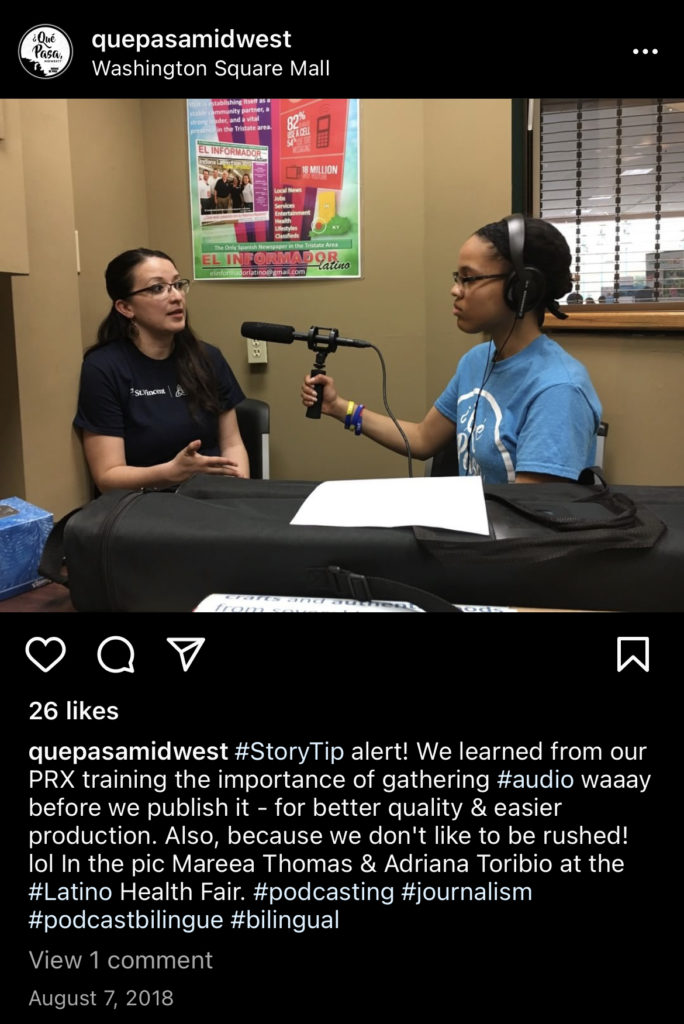Q&A with Mareea Thomas: How WNIN shares people’s stories in their own words
This Q&A is part of a new INN series on how nonprofit news outlets serve communities of color. You can find more Q&As here.
Who: Mareea Thomas, Director of Digital Media at WNIN Tri-State Public Media and co-producer of the ¿Qué Pasa, Midwest? podcast
News outlet: WNIN Tri-State Public Media
Size of outlet as of January 2022: 21 full-time employees
Outlet launch year: WNIN incorporated with the state of Indiana in 1973. ¿Qué Pasa, Midwest? launched in 2017 through PRX’s Project Catapult.
Tell us a bit about your news outlet. What sort of coverage and services does WNIN provide? What’s your outlet’s primary mission?
As a dual radio and television licensee, WNIN provides NPR and PBS content as well as statewide and local news. WNIN primarily serves the greater Evansville area which includes parts of Indiana, Kentucky and Illinois. We also host a Radio Reading Service, in which volunteers read local newspapers for visually impaired listeners, and other local programs like the bilingual podcast ¿Qué Pasa, Midwest?. WNIN’s stated mission is to use public media to enrich people’s lives and better our communities. ¿QPM? serves Midwestern Latinos by sharing authentic, bilingual stories of Latinos living in the region.
Tell us about yourself! How did you get into radio, and when did you start working at WNIN? What drew you to ¿QPM? and what does your role look like?
I am from New Orleans and moved to the Midwest after Hurricane Katrina. In college I was a producer at the radio station for an international music show called The World Safari. In one of our segments I interviewed international students, which I loved—it’s still one of my favorite things I’ve ever worked on. I have always enjoyed talking to people from different countries and cultures.
I started working at WNIN in January 2016 as a radio host and producer. While I’m Black, but not Latina, ¿QPM? creator Paola Marizán invited me to co-produce the podcast due to my Spanish minor and production experience with The World Safari. In my current position I manage WNIN’s social media accounts and website in addition to producing ¿QPM?. After securing funding at the end of 2021, I am in charge of launching and managing ¿QPM?’s expansion into a bilingual reporting network.
¿QPM? is six years old! Could you tell me more about how this podcast came together? When did WNIN understand it needed to create a new product for Spanish speakers? How did you design the podcast?
Paola Marizán was reporting about Spanish speakers for WNIN, but her work wasn’t reaching the Spanish-speaking community. In addition to the stories being primarily in English for our NPR audience, they were aired on an NPR station with content geared towards white business professionals and scheduled during work hours. Paola (who works for America Amplified now) proposed creating a podcast since people can listen to it on demand, and it isn’t bound by the restrictions of NPR radio features in terms of length and language. The team took part in PRX’s Project Catapult, where we learned to use design thinking to come up with bilingual, eight to 15 minute episodes covering the stories, challenges and triumphs of Latinos living in the Midwest.
For more of our podcast origin story, check out Paola’s January interview with KQED’s Ernesto Augilar about the need for bilingual content.
Who does ¿QPM? primarily serve, and how do you know this? Is your current audience different from who your outlet intends to serve?
¿QPM?’s intended audience has always been Midwestern Latinos. However, we’ve seen that the stories appeal to people outside of the Midwest and to non-Spanish speakers as well. According to our analytics, quite a few of our listeners are located in Mexico and other countries, including Venezuela, which was a pleasant surprise.
Can you talk a bit about ¿QPM?’s approach to bilingual audio?
As a bilingual podcast, we actually do not use direct translations! We paraphrase things in English and Spanish. There’s a language mix so English-only or Spanish-only speakers understand most of the episodes. We made the decision early on that if a non-Spanish-speaker can’t understand every single word, that’s okay since they aren’t our target audience, and they can still get the gist of the episode. This medium means that you’re hearing the voice, hearing the dialect, the switching back and forth between Spanish and English—the authenticity of that.
Did the podcast team make any mistakes early on that helped with the podcast’s development? How has the podcast changed over time?
When we started, we were going out and looking for stories that we thought Midwestern Latinos would find interesting. Now we’re going to our collaborators and community leaders asking, “Who should we talk to? What should we talk about?” Moving forward we will be directly asking Midwestern Latinos what topics and issues they want us to cover.
In 2020, we were supposed to do a season about the election, but then the pandemic hit and it was all we could think about. There was a lot of fear, confusion and uncertainty. We realized we couldn’t even really “report” on the virus because there wasn’t enough information. Our collaborators agreed and we shifted to finding the people who were coming up with solutions. Ever since that season, I’ve felt like that is the path we should stay on, unless our audience tells us to do something else. Not just reporting and exposing problems, but also connecting people to problem solvers and solutions in the community. We don’t want to just tell Latinos’ stories, we want to listen, share stories, share information and connect people.
How do you think about or measure the reach and impact of this podcast? What sort of feedback have you received from its audience?
One of our goals in terms of reach is to have content originating from all 12 Midwestern states, but our reach and impact has been evident from how many Latinos inside and outside of the Midwest have shared positive comments about the podcast. Some of our feedback comes through our collaborators sharing episodes on their social media. Our episode on Latinos & Freedom of Speech was a collaboration with April Alonso, a multimedia journalist who co-founded the bilingual news outlet Cicero Independiente in Cicero, Illinois. Cicero Independiente tagged ¿QPM? in their episode post on Twitter which led to ¿QPM? receiving positive feedback from Illinois and beyond.
What advice do you have for other news organizations who are planning on launching a new product specifically for communities of color? What should they be thinking about early on?
Using community engagement to research the underlying issues is key. Establishing rapport with community leaders is important for building trust; our regional collaborators, community partners and organizations who already have connections in their communities are gateways to Midwestern Latinos. In a bilingual community, having a host like Paola who speaks the language—especially if it’s their first language—breaks down some barriers immediately.
Early on, it’s non-negotiable to have at least one team member who is part of the community. But that person can’t just be the face; they need to be a decision maker, and the organization must defer to their expertise. It’s essential that they be well compensated for their time, unique insights and talents. If the new product falls apart due to one employee leaving, then the organization can’t sustain that product in a meaningful way. Serving a community isn’t a one-person job; it needs to be a group effort, and it’s important to continue diversifying staff, increasing cultural awareness and providing adequate resources for the team long after launch. A culturally competent product requires stewards who ensure that people can speak their truth in their own words; this is a major way to change an industry primarily influenced by and catering to white audiences.

It’s also crucial to think about safety for the team members and people who share their stories. We have seen this with issues related to immigration, the U.S. Census, the 2020 election and COVID-19, for example. We have had at least one story that was compelling, but we didn’t release it because we realized that we could be unnecessarily placing the subjects in danger.
Prioritizing safety over producing a compelling story is a shift away from the mindset of seeking recognition and awards. Making the shift can be difficult because recognition is what brings revenue and revenue is what allows us to continue. Ultimately, serving communities is about providing value to them and putting their needs over content production.
What’s next? Is there something you’re looking forward to in 2022?
We received the seed funding to expand the podcast into the ¿Qué Pasa, Midwest? Bilingual Reporting Network which will launch later this year. With the network design, I’m thinking about increasing accessibility for people with auditory, visual and/or mobility needs. Our monthly newsletter will include a ¿QPM? episode and articles based on themes submitted through a WhatsApp group. We’re also exploring how to voice the written articles and transcribe the podcast episodes while maintaining our bilingual approach. A local professor is making our content into free lesson plans to serve younger generations, and we will also make broadcast features available to stations nationwide.
Read more from the series here.
